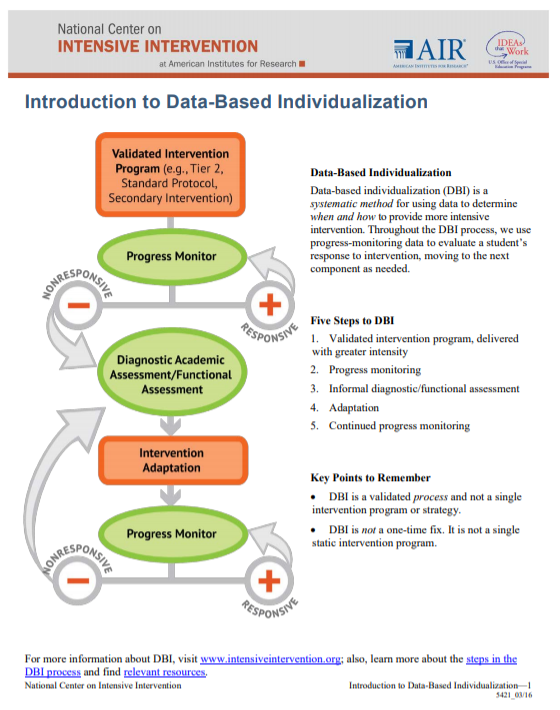Data-Based Individualization Case Study Part Four

Mr. Williams has now conducted the diagnostic assessments and determined that there is an adaptation needed to Joe’s current instruction. He consults the DBI process chart and moves to the next step, instructional adaptations.
Let’s see how Mr. Williams adapts Joe’s current reading intervention.

(Source: National Institute for Intensive Intervention)
Based on the results of the assessments, Mr. Williams has identified the skills that Joe needs additional instruction in. He consults the DBI chart and has determined that an instructional adaptation is needed. Based on his 4 weeks of progress monitoring data, along with the additional diagnostic assessments, Mr. Williams can begin to make instructional adaptations for Joe.
Mr. Williams consults his training materials from his summer professional development on implementing the DBI process. He consults the NCII recommended changes for instruction on their DBI website.
He creates a chart of the recommended adaptations to instruction:
| Adaptation | What is it? | Change Made? | Why? |
| Dosage | Changing the amount of intervention, a student receives | YES | Increase intervention time by 45 minutes a day |
| Change the Learning Environment | Changing the number of students, location, etc. from the learning environment | NO | Intervention group is currently 3 students in a structured environment with limited distractions |
| Teach Cognitive Process Strategies | Teaching strategies for processing and organizing information | YES | Including goal setting and self-monitoring of progress |
| Modify Instructional Presentation | Modifying instruction by using the elements of explicit instruction | YES | Make a change to the amount of immediate corrective feedback during lessons |
| Adaptations to Instructional Program | Adding additional elements of instruction along with validated Tier II program | YES | Along with continuing the Tier II reading program, additional instruction and practice for sight words and words with long vowel and multi-syllabic words |
To begin making instructional adaptations, Mr. Williams looks first at the dosage of Joe’s intervention to see if a change needs to be made. Joe is currently receiving 30 minutes of reading intervention daily. Mr. Williams decides that in order to implement the instructional changes for Joe, he will increase his intervention time from 30 minutes a day to 45 minutes a day.
After making a change to Joe’s daily time, Mr. Williams looks to see if he needs to change the learning environment. Joe is currently receiving intervention with two other 4th grade students. Mr. Williams classroom is highly structure with little distractions. Mr. Williams determines that a change is not needed.
Now Mr. Williams looks at the including cognitive strategies along with instructional strategies. Mr. Williams decides to implement goal setting and self-monitoring during Joe’s intervention time. The Tier II reading intervention tells students what they will be learning and what they will be able to do at the end of the lesson. Joe responds well to this portion of the program so Mr. Williams decides to include this in his adaptations. To help Joe self-monitor his progress, he will implement a goal for instruction for the week along with a way for Joe to monitor his progress. Since Joe will be working on sight words, Mr. Williams creates a data tracking sheet for his sight words accuracy. Joe can track his percentage of words correct and track what words he need to practice more with. Mr. Williams will be using a word identification fluency probe with Joe to progress monitor his progress with long vowels and multi-syllabic words. He will create Joe a data sheet where he can track his progress with accuracy of decoding.
Mr. Williams examines the Tier II instruction to see if a presentation change needs to be made. He decides to increase the amount of immediate and corrective feedback during the lesson for both the group and individual responses. Mr. Williams will monitor the student’s responses closely and provide additional feedback during the lesson. Mr. Williams will also increase feedback for Joe during his additional instruction time.
Finally, Mr. Williams decides to make some instructional changes to the Tier II intervention. Joe will continue to receive the 30 minutes of group instruction using the Tier II intervention daily. Additionally, Mr. Williams will work with Joe on decoding skills for long vowels and multi-syllabic words and sight words during his extra instructional minutes.
Mr. Williams has identified the instructional changes that he will make to Joe’s instruction based off the diagnostic assessments. Mr. Williams will now create a plan for progress monitoring based off the instructional adaptations.
Let’s visit Case Study Part Two to see how Mr. Williams uses the instructional changes to create a progress monitoring plan.
Click on the image below to see Case Study Part 5.
References:
DBI Process Overview. (n.d.). Retrieved October 27, 2019, from https://intensiveintervention.org/resource/dbi-process-overview.
What Do I Do Now? Individualizing Academic Interventions when Standard Approaches Don’t Work (DBI Professional Learning Series Module 7). (n.d.). Retrieved October 27, 2019, from https://intensiveintervention.org/resource/what-do-i-do-now-individualizing-academic-interventions-when-standard-approaches-dont-work.
